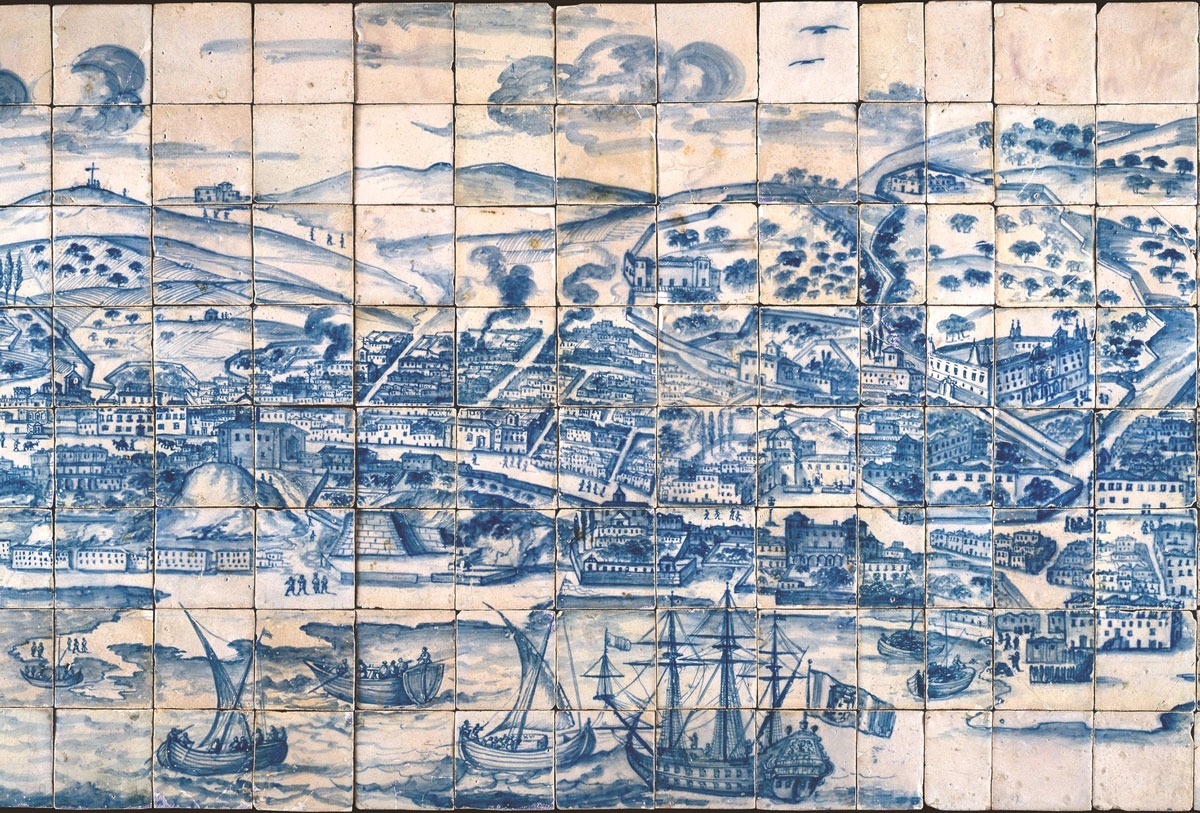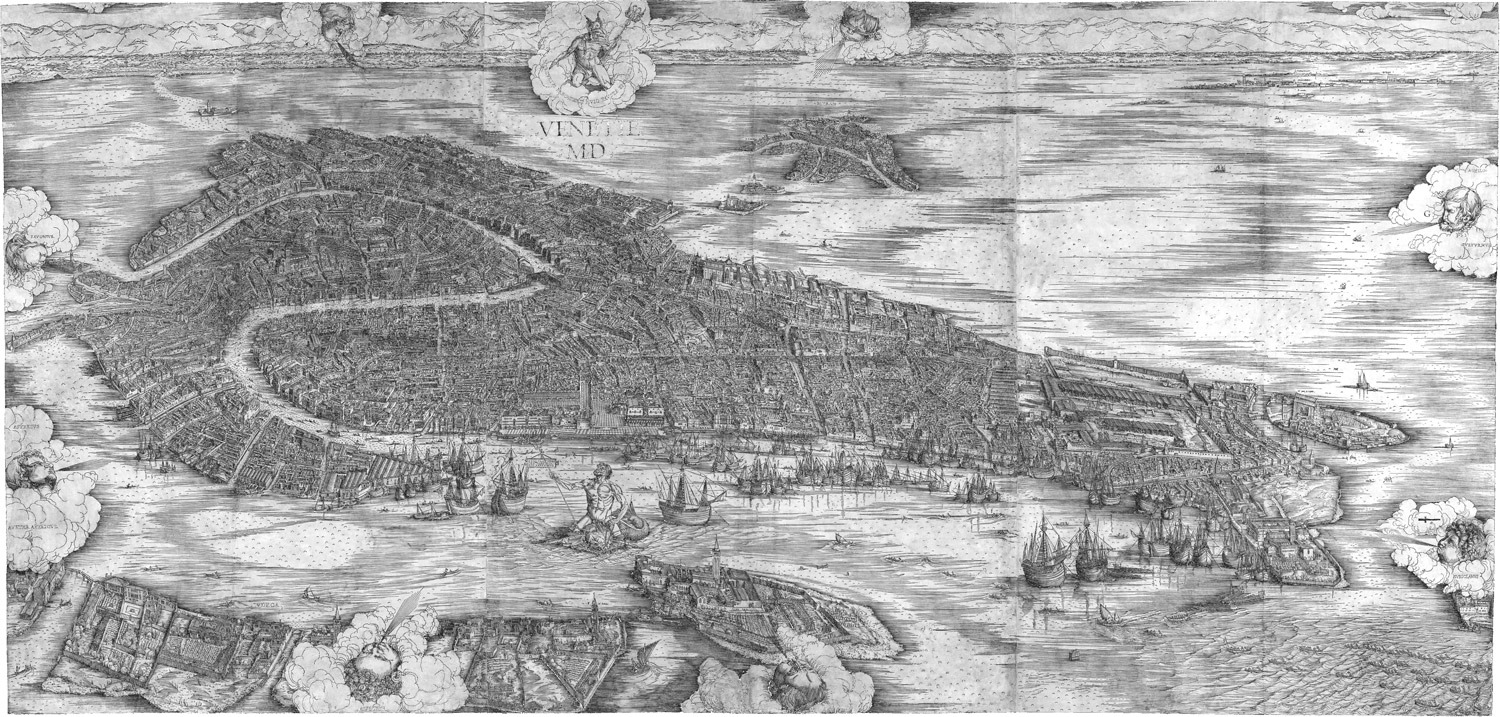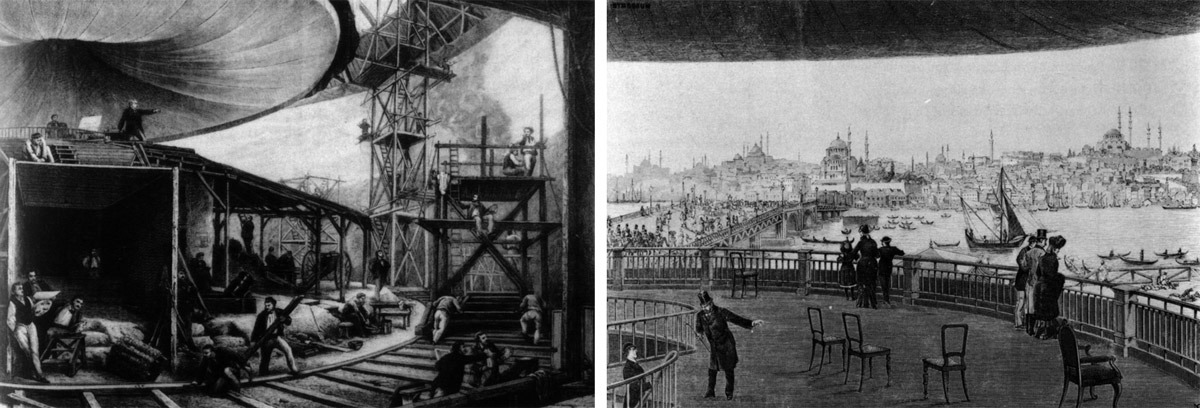
Assembly of perspectives: a grande vista de Lisboa
Gabriel del Barco’s masterpiece ‘A Grande Vista de Lisboa’ is a patchwork of tiles that pulls our gaze into the heart of a stratified city, where buildings, gardens, people and churches float on the surface of an ever-shifting fabric. This is the image of a Lisbon whose elements are not in unison, and perhaps it could not be any different: the Portuguese capital emerges through fragments that reconstitute its vital nature, leaving both spectator and author caught between the perspective of an ideal encompassing view and the shaking forces that govern the everyday experience of the city.
The Lisbon Panorama is perhaps one of the largest urban panoramas in the world. It consists of 16 tile panels with a total of 1.12 meters in height by 22.46 meters in length. Having previously belonged to the Palace of the Counts of Ferreira and Tentugal, it is currently mounted and permanently on display at the Lisbon Tile Museum. The panel is attributed to Gabriel del Barco (1649-c.1703) and depicts a view of late 17th-century Lisbon from Algés to Xabregas in an extension of 13 kilometres, just a few years before the tragic 1755 earthquake that left most of the city totally destroyed. Considered an iconic work of great value, very little is known about the project of the panel, the context in which it was made and, above all, the technical processes adopted in its design. Palaces and fortresses are represented, churches and convents, markets and fountains, water mills, pillories and other Christian symbols and numerous characters and animals engaged in different tasks that allow us to somehow perceive the movement and life of the city of Lisbon at the time.1
The panel is so long that it is not possible to have at one glance a perception of its entirety and at the same time of the multiple elements that compose it. Perhaps this is why, in its current assembly at the Tile Museum, it is presented in a circular (concave) wall composed of several flat modules, so that the viewer, at a distance of some meters and perpendicularly to its centre can, gradually turning his head, see the whole territory and many buildings. One of the most interesting aspects of this urban panorama is the way the whole city and its many buildings seem to have been designed. At the end of the seventeenth century, it would have been possible to implement different methods or the simultaneous combination of various procedures, from the use of topographic plans and maps (aerial views), measuring and topographical instruments, linear or orthogonal perspective, to even drawing on-site assisted, or not, by optical and mechanical drawing devices.

Fig 1. Jacopo de’Barbari. Venetie MD, 1500. Venice, Museo Correr, Inv. Cl. XLIV n. 56.
However, there are several factors that tell us that any of these isolated procedures or the articulation with others might not have been used. First of all, it is not exactly an aerial view where the buildings are uplifted from the city plan, as it was possible to do geometrically two centuries earlier and as we can see from the magnificent aerial view of Venice from c.1500 by Jacopo de Barbari (Fig 1). Although this author may have implemented different procedures, it is thought that he would have used a strictly cartographic process, using the city plan and afterwards techniques and topographic survey instruments for the representation of the perspective elevations.2
In the case of the Lisbon tile panel, the situation is quite different. In fact, although some parts of the panel appear to be represented from above (Fig 2) it is a front view of Lisbon where the facades are clearly more visible than the roofs of the buildings (Fig 3).

(Left) Fig 2. Panel #7, Lisbon Panorama. (Right) Fig 3. Panel #8, Lisbon Panorama.
On the other hand, if a geometric construction had been implemented, based on the city’s plans, elevations and architectural elements, using linear perspective with a central vanishing point placed in the center of the image, as one shifts one’s gaze towards the left and right ends of the panel one would be confronted with a great perceptual distortion of the buildings. This is because when we see and draw according to the principles of linear perspective, the viewer is forced to a main point of view, where he should be still, without turning his head and subject to the limitations of his visual field which are approximately a 60-degree angle (Fig 4).

Fig 4. La Città Ideale, 15th century. Urbino, Galleria Nazionale delle Marche.
In this beautiful 15th century painting (Fig 4), where the principles of linear perspective are praised and where the vanishing point is central, the image is only credible and optically possible because its length is relatively short. That is, if the extension of the city, to the left and right side were much longer, we would be facing a perspective aberration where the end buildings would be gradually more and more distorted. This situation and vantage point are not, in fact, compatible with the extent of the territory represented in the Lisbon Panorama (13km on a 22m panel), even if we placed the observer geometrically at the ideal distance (…). But the ideal and static Italian city is quite different from the bustling Lisbon and from the many stories that are told through its tiles.
Another technical procedure that could have been implemented at the time, and which would be relatively simple and compatible with the conceptual assumptions of the Lisbon Panorama, would be to resort to a boat or a ship along the bank and then choose a series of viewpoints and draw step by step the city, assembling in the end the several images into one unique view.3
An analogous procedure to this one was implemented much later in the mid-nineteenth century in the famous European Panoramas that would attract hordes of people and where, as a rule, great panoramic views of famous cities were represented (Figs 5, 6). It is believed that most of these panoramas, built inside giant galleries and painted along the inside of a cylindrical section, were designed using optical and mechanical drawing devices, namely the camera obscura.4
For this, a sequence of previous drawings would be made on a rotating platform, and the drawings were then joined side by side and enlarged for the final painting to complete a 360-degree view. However, the view that Gabriel del Barco proposes us is not a 360-degree view of the city but a longitudinal view along the Tejo river defined by 16 flat and rigid panels that may possibly have covered several walls, for instance in a cloister.

(Left) Fig 5. Félix-Emmanuel-Henri Philippoteaux inspecting the construction of the Panorama of Champ-Elysées in Paris, print, Le Monde illustré, 2 Nov 1872.
(Right) Fig 6. C. V. Nielsen. View from the panorama platform of Constantinople by Jules-Arsène Garnier, print, c.1882. Museum Udstillinger, Copenhagen.
Although we admit that simpler procedures could have been used in the tile panel, for example, making successive drawings along the bank showing only the facades of buildings positioned perpendicular to the viewer, and more perspective-like facades of those that were turned otherwise, there are numerous factors that tell us that Gabriel del Barco implemented considerably different and more simple drawing procedures.5 The use of on-site drawing for most of the panel seems to be out of the question, as most buildings in perspective facades almost always adopt the orthogonal perspective, close to the military perspective. At most, we admit that the author was in various locations around the city to survey and measure specific buildings, but in transposing them to the panel, he adopted not the conical perspective or the on-site drawing made, but rather the orthogonal perspective.
It seems that the author, being an excellent tile artist for the vast work he has left us, would not draw in a consistent manner from sight, nor would he know of perspective, geometry, cartography, or geometric construction. In fact, there are numerous incongruities in the Lisbon Panorama: the relative scale of some buildings does not fit reality; there are many errors in the perspective of buildings that are side by side; in some panels the linear (conical) perspective is juxtaposed with orthogonal perspective; the depth axes of some objects and buildings are placed to the left, while others are placed to the opposite side; perspective on the hills defies the laws of gravity, etc.

(Left) Fig 7. Panel #12, Lisbon Panorama. (Right) Fig 8. Panel #13, Lisbon Panorama.
Being practically an impossible mission given the length of the panel and the extent of the city territory represented, the procedure that seems to have been adopted, even if full of incongruities and naïf, is to some extent ingenious and seems to be one of the most interesting aspects of this view of Lisbon. The author presents us with a portrait of his time and represents the life of the city in a story (panorama) built by several episodes (panels). It is, in fact, a giant collage of images, most of them probably made originally by other authors in other contexts.
It’s very unlikely that Del Barco actually visited all the places and buildings that he represents. His experience of place can, therefore, be considered virtual, or somewhat fragmentary like our perception of the world when we surf on the internet to get acquainted with a certain place we have never visited. From panel to panel, from building to building – frame by frame – we move across a patchwork Lisbon, as perceived by Gabriel del Barco and his contemporaries. A work based on the appropriation of paintings, drawings and graphic documents, on the memory and tradition from that era where the idea and the construction of landscape were mediated mostly by images.
Footnotes & references
[1] For further information see: https://www.museudoazulejo.pt/pt-PT/ExposAct/ExpoPerm/ContentDetail.aspx?id=966
[2] NUTI, Lucia. Prospettiva e strumenti di misura nella costruzione dei ritratti di città. In: CAMEROTTA – Nel Segno di Masaccio, p. 275.
[3] It would not be possible for the draughtsman to be on the other bank of the river because it is not actually a river that separates the two sides in this area, but an estuary, which measures approximately 2km from one bank to the other.
[4] See: MAIA, Pedro. Máquinas de Desenho e a Representação da Realidade. O mundo Visto por uma Janela. FBAUP, Porto, 2010, pp.453-470.
[5] In a paper that will be presented in November 2019 in Granada for the ARS & URBS Research Project, the panel is analysed in a more scientific way regarding the procedures used by the author. This project, which involves the Faculty of Fine Arts of the University of Porto and Drawing Departments of other Spanish Universities, analyses urban views designed in the Iberian Peninsula between the 16th and 19th centuries.
Recent articles

Southern California is many things. Quite infamously, it is known as a landscape defined by the automobile, from the emergence and diffusion of the highway system to fast food burgers, and the suburbanization of the United States. Walking this place then, would seem not only inconvenient, but ill advised. In… Read more »

What is today known as ‘whistleblowing’ could once take the form of interacting with a threatening gaze carved into the city wall. It is the case of the ‘boche de Leon’ or ‘lion’s mouths’ disseminated by the old Venetian Republic throughout its territory to suppress illegal activities. Through a close… Read more »

As he navigates through the recurrent lockdowns of the pandemic, stranded between hitchiking and muggings, job hunting and separations, Fabio Valerio Tibollo rediscovers photography as a powerful coping mechanism. Recording everything that happened around him for one year straight, from attending momentous events to finding curiosity in shots of simple living,… Read more »

